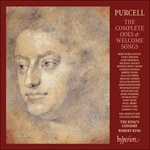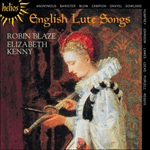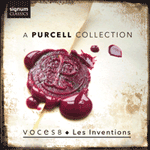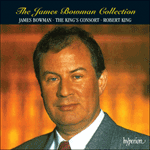
Welcome to Hyperion Records, a British classical label devoted to presenting high-quality recordings of music of all styles and from all periods from the twelfth century to the twenty-first.
Hyperion offers both CDs, and downloads in a number of formats. The site is also available in several languages.
Please use the dropdown buttons to set your preferred options, or use the checkbox to accept the defaults.

But the highlight of the work, a movement which surely ranks as one of Purcell’s greatest, is the alto solo, set over a wistfully sighing four-bar dropping ground bass, ‘By beauteous softness’. One of Purcell’s most ravishing solos, especially with its quietly ecstatic vocal line at ‘She with such sweetness’, the voice’s final phrase is overlapped with an exquisite five-part string ritornello of quite melting beauty.
from notes by Robert King © 2010
Mais l’apothéose de l’Ode, c’est le solo d’alto déployé par-dessus un ground bass descendant, tristement soupirant, de quatre mesures, «By beauteous softness»—certainement parmi les plus grandioses mouvements et les plus ravissants solos purcelliens, surtout avec sa ligne vocale extatique à «She with such sweetness», la dernière phrase vocale se chevauchant avec un exquis ritornello de cordes à cinq parties, d’une beauté toute attendrissante.
extrait des notes rédigées par Robert King © 2010
Français: Hypérion
Der Höhepunkt dieses Werks ist jedoch ein Satz, der zu den besten von Purcell gezählt werden muss, nämlich das Alt-Solo, „By beauteous softness“, das über einem wehmütig seufzenden, viertaktigen und absteigenden Basso ostinato erklingt. Es ist dies eins der hinreißendsten Soli Purcells, besonders bei der still-ekstatischen Passage „She with such sweetness“, wenn die letzte Phrase der Gesangsstimme sich mit einem vorzüglichen fünfstimmigen Streicher-Ritornell überschneidet.
aus dem Begleittext von Robert King © 2010
Deutsch: Viola Scheffel
 Purcell: The Complete Odes & Welcome Songs Purcell: The Complete Odes & Welcome Songs‘A treasure house of shamefully neglected music. Over nine hours of wonderful invention … this major recording achievement must be an irresistibl ... ‘By any yardstick these are life-enhancing works’ (CDReview)» More |
 English Lute Songs English Lute Songs‘Robin Blaze has the special ingredients to transcend any latent prejudice [of countertenors], especially in a recital as wide-ranging and intelligent ... ‘Can be recommended without reservation … the wonderful 'By beauteous softness’, from Queen Mary’s Birthday Ode of 1689, given this performance, ...» More |
 Purcell: A Purcell collection Purcell: A Purcell collectionThe young, virtuoso A Cappella ensemble Voces 8 returns to disc on Signum with a sumptuous collection of early works by Henry Purcell.» More |
 The James Bowman Collection The James Bowman Collection'The James Bowman Collection' deserves the strongest and warmest of recommendations … This is glorious music-making and deserves the widest possible hearing' (The Daily Telegraph) 'La intensa expresividad, la técnica y el color de la voz d ... » More |

